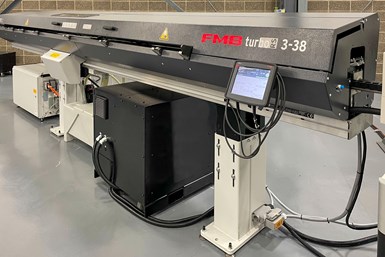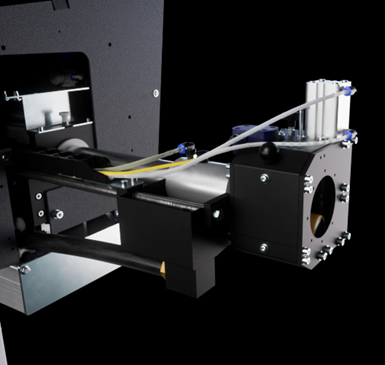
The Revolutionary Sliding (RS) technology available on FMB Turbo 3-38 bar feeders is said to minimize vibration and harmonics and enable high-speed rotation by providing more material support compared to conventional bar feeder designs. (Photo credit: PM)
It seems a number of manufacturers have what they call “Covid projects.” That is, projects in which a new product is developed or an existing product is reimagined. It was the latter for German bar feeder manufacturer FMB (represented in the United States by Edge Technologies) with what it calls Revolutionary Sliding (RS) technology.
Developed specifically for sliding headstock Swiss-type lathes, the company says this patented design is the first in the industry to fully support the bar pusher and stock from inside the bar feeder all the way into the lathe spindle.
Featured Content

With RS technology, the bar feeder steady rest mounts directly to the back of the machine tool’s headstock. (Photo credit: Edge Technologies)
It started with its flagship magazine bar feeder, the FMB Turbo 3-38. Instead of the telescopic device that traditionally separates the machine tool and bar feeder, the bar feeder uses RS technology.
Its steady-rest mounts directly to the back of machine tool’s headstock, providing material support at the back of the spindle, while an extension tube (what could be considered a sliding spindle liner) is internal to the bar feeder, instead of only external for full material support. Material travels inside the extension tube, eliminating the large gap between the channel set and steady rest. The tube provides a constant diameter of support for the material, unlike conventional telescopic tubes external to the bar feeder. This is especially important for difficult bar stock, as well as hex stock, to minimize potential vibration and harmonics.
The integrated and lubricated sliding guide module and moving steady rest provide significant bar pusher and stock support in the transition zone between the bar feeder and lathe spindle. FMB’s RS technology eliminates the need for telescopic noses, extended pushers and Z-axis axial track, all of which were accessories designed to minimize the gap between the bar feeder and machine tool. The design also eliminates the need for an axial shift device or pusher extension to make the bar feeder “longer” for non-guide-bushing/chucker applications.
Even though the physical bar feeder is a bit longer to accommodate RS technology, the unit can be installed closer to the back of the machine tool, which actually means less floorspace is required compared to a traditional bar feeder.

The bar pusher and bar stock are fully supported by the sliding guide module from inside the bar feeder to the machine tool spindle. Continuous oil floods the system providing hydrodynamic support further enhancing bar stability and heat dissipation. (Photo credit: Edge Technologies)
“The patented sliding guide module represents a significant advancement in providing superior bar stability and RPM performance,” notes Kevin Meehan, president of Edge Technologies.
FMB Turbo 3-38 bar feeders with RS technology feature the same design elements as those without RS technology. This includes bar diameter capacity of 3 to 38 mm (0.118" to 1.500"); automatic loading magazine with 11" linear rack capacity; a compact double-pusher design; a polyurethane guide channel system, which damps noise and vibration; quick-change guide channels and pushers to enable 10-minute, full changeover and 3-minute changeover within same channel set; hydrodynamic support via high volume oil flow into channels; Bosch motion control to provide easy bar feeder parameter changes with remote pendant; and a separate, floor-mounted electric cabinet to isolate electronics from vibration.
RELATED CONTENT
-
Video Tech Brief: Bar Feeder Technology Optimized for Swiss-Types
This bar feeder design is said to offer high guidance quality with minimum vibration and noise development for sliding-headstock machines.
-
Video Tech Brief: Live-Tool, Y-Axis CNC Lathe with a Compact Footprint
This small footprint, big-bore lathe offers a generous work envelope. The addition of Y-axis and live tooling enables milling, drilling and tapping for increased machine capabilities.
-
Broaching Tool Technology For Lathes Used to Slot Inconel Parts
This shop finds value in using an indexable-insert-style broaching tool to create blind-hole slots in heat-treated Inconel aerospace parts on a CNC lathe.






